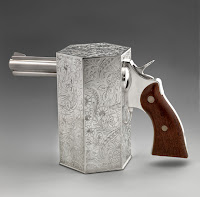Why I believe in gun control—
This I believe essay. Note: I believe. This is why I support gun control. This is why I want my legislators to support gun control. I'm not trying to change your view--this is not meant as a persuasive essay full of supportive information. But I ALSO believe that the more we talk about why we believe what we do, the more we begin to have reasonable open dialogue which respects our mutual humanity and works for commonality. I hope you believe that bit.
- · Because my father collected guns and used them for hunting and target practice. I was taught to use guns as a tween, with the understanding that guns are killing machines and should always be used as if they will kill every time you touch one. I remember being shown the can I shot the first time and told “If this bullet can go through metal like this, think about what it can do to the human body.” I believe that all guns are weapons and must be treated as such, no matter your use.
- Because my models showed me the importance of responsibility: my father renewed his gun license and my mother did a class before receiving her license. I believe that background checks should be universal. There should be no loopholes for purchase at gun shows or on the secondary market. Training should be an expectation of the state, not a voluntary action.
- · Because in 1996, my brother Brian Henry Altvater was murdered, at 20 years old, by his childhood friend. This is a grief I bear always. I have now lived more years without my brother than with him; I regret that tremendous loss. As I read about the victims of the Orlando shooting, most of them in their 20s, I am reminded of the emptiness that sucks your life out when you hear the news, the bleakness of waiting for news and resolution, and that shock that hits back when you do not realize it will. I believe that no one else should have to experience that.
- · Because the man who killed my brother used a gun that was legally owned. I believe in trigger locks to prevent the use of legally owned guns by individuals who are not authorized by the owner to use the gun. Accidents caused by children not understanding the lethality of the weapon are now a major regular occurrence. I believe that we need to be responsible for our actions that affect our children and their actions.
- · Because the man who killed my brother claimed, in defense and appeal, a brain injury and a psychiatrist-diagnosed dependency disorder that could have explained his actions under the stress of potential change in their relationship by my brother’s engagement and job change. While this was undiagnosed at the time of my brother’s murder and would not have changed my case, it will change the case for others. I believe that we need to treat mental issues more carefully and support the strengthening of regulations that keep guns out of the hands of individuals who have psychiatric concerns. I believe that strengthening also includes individuals who have misdemeanor domestic violence convictions, misdemeanor hate crime convictions, suspected terrorism (no fly list). I am comfortable with the exclusion of more individuals, though I know that others disagree.
- · Because I support our police and military. I believe that we should support those who fight for our safety. But these are the ONLY individuals who should have the ability to mass fire weapons. These guns fire 13 bullets per second with incredible force. Military-style assault weapons and high capacity magazines should be forbidden to regular individuals.
- · Because I am raising two beautiful children. I believe I can’t tell you more clearly. In seeing the horrors of Sandy Hook where children were gunned down in the safe place of their school, or the Aurora movie theater, or the shopping center in Tucson, I cannot believe that we can make the world completely safe for them but that we are obligated to try, just as we try to protect them from the hazards of smoking/second-hand smoke, alcohol, driving, etc. Because I continue to explain why our playground is named for a little girl named Ana Grace Marquez-Greene who died at Sandy Hook and why the flags at my workplace are at half-mast today. I want to honor children for their lives not mourn them in their deaths.
- · Because I am bisexual, because my daughter identifies as gay, because my husband and children are Jewish. I believe that we need to support our minority communities. I believe that we need to use our words and actions to make it difficult to be racist, bigoted, and hateful. I believe that we need to use our words and actions to heal isolation and wrongs and to be aware of our privileges.
- · Because I teach at a university. I believe that the pressures in that community argue strongly for better mental care and support NOT concealed carry laws. I believe that a “good guy with a gun cannot necessarily stop a bad guy with a gun”, that this is a job for those with training and access—the police.
- · Because I am white, middle-class, Christian. I believe I have undue social/cultural privileges by virtue of nothing more than the accident of birth. I believe gun violence in America disproportionately ruins the lives of Blacks and Latinos, the urban poor. I believe that my voice and my vote and my actions matter to my fellow beings and I have a responsibility.













